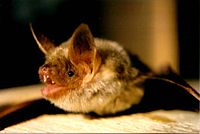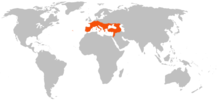- Greater mouse-eared bat
-
Greater mouse-eared bat 
Conservation status Scientific classification Kingdom: Animalia Phylum: Chordata Class: Mammalia Order: Chiroptera Family: Vespertilionidae Genus: Myotis Species: M. myotis Binomial name Myotis myotis
Borkhausen, 1797
The greater mouse-eared bat, Myotis myotis, is a European species of bat in the Vespertilionidae family.
Contents
Description
It is relatively large for a member of the Myotis genus, weighing up to 45 grams (1.6 oz) (a little larger than a house mouse, Mus musculus), making it one of the largest European bats.[1]
Foraging
Like its relatives it eats various arthropods; however, unlike many bats it does not capture prey by echolocation in flight but instead gleans it from the ground, locating the prey passively – listening for the noises produced by creatures such as carabid beetles, centipedes and spiders.[2] Thus, it uses echolocation only for spatial orientation, even if it emits ultrasound calls when approaching prey.[3]
Roosts
In summer, nursery roosts in northern Europe are located almost exclusively in large attics of buildings (e.g. churches), while in southern Europe they are located in caves. Also solitary males can roost there, although in some countries (Germany, western Poland) there are regular cases of roosting in bird and bat boxes. Greater mouse-eared bats spend winter exclusively in underground roosts, like caves, mines, forts, tunnels and large cellars.
Echolocation calls
The frequencies used by this bat species for echolocation lie between 22 and 86 kHz, have most energy at 37 kHz and have an average duration of 6.0 ms.[4]
Distribution
The greater mouse-eared bat can be found in the following countries: Albania, Andorra, Austria, Belarus, Belgium, Bulgaria, Croatia, Cyprus, Czech Republic, France, Germany, Gibraltar, possibly Greece, Hungary, Israel, Italy, Jordan, Lebanon, Liechtenstein, Luxembourg, Malta, Netherlands, Poland, Portugal, Romania, Serbia and Montenegro, Slovakia, Slovenia, Spain, Switzerland, Syrian Arab Republic, Turkey, Ukraine, and the United Kingdom.
Great Britain
During the 20th century this species was known as a very rare one in Great Britain, occurring only in southern England. However, the bats at the only known hibernation roost declined until only a few males were left, and when these disappeared the species was believed extinct.[5] However, in recent years occasional individuals have been discovered, suggesting either that a colony survives, or that further animals have colonised from mainland Europe.[6]
References
- Chiroptera Specialist Group 1996. Myotis myotis. 2006 IUCN Red List of Threatened Species. Downloaded on 9 July 2007.
- ^ Van den Brink, F H, A Field Guide to Mammals of Britain and Europe, Collins 1967, ISBN 0 00 212093 3
- ^ Siemers, B.M., and Güttinger, R. (2006) 'Prey conspicuousness can explain apparent prey selectivity.' Current Biology., 16 (5): R157-R159.
- ^ Russo, D., Jones, G. and Arlettaz, R. (2007) 'Echolocation and passive listening by foraging mouse-eared bats Myotis myotis and M. blythii.' The Journal of Experimental Biology., 210: 166-176.
- ^ Obrist, M.K., Boesch, R. and Flückiger, P.F. (2004) 'Variability in echolocation call design of 26 Swiss bat species: Consequences, limits and options for automated field identification with a synergic pattern recognition approach.' Mammalia., 68 (4): 307-32.
- ^ Species Action Plan: Greater Mouse-eared Bat (Myotis myotis)
- ^ BBC Inside Out: The Search for the Greater Mouse-eared Bat
Categories:- IUCN Red List least concern species
- Mammals of Europe
- Mammals of Asia
- Mammals of Turkey
- Mammals of Syria
- Mammals of Lebanon
- Fauna of the Palestinian territories
- Mammals of Israel
- Mammals of Jordan
- Fauna of Gibraltar
- Mammals of Spain
- Mammals of Portugal
- Mammals of Andorra
- Mammals of France
- Mammals of the United Kingdom
- Mammals of Monaco
- Mammals of the Netherlands
- Mammals of Belgium
- Mammals of Luxembourg
- Mammals of Germany
- Mammals of Denmark
- Mammals of Sweden
- Mammals of Switzerland
- Mammals of Liechtenstein
- Mammals of Austria
- Mammals of Italy
- Mammals of San Marino
- Mammals of Slovenia
- Mammals of the Czech Republic
- Mammals of Slovakia
- Mammals of Poland
- Mammals of Belarus
- Mammals of Ukraine
- Mammals of Moldova
- Mammals of Romania
- Mammals of Bulgaria
- Mammals of Croatia
- Mammals of Bosnia and Herzegovina
- Mammals of Serbia
- Mammals of Montenegro
- Mammals of Kosovo
- Mammals of Hungary
- Mammals of the Republic of Macedonia
- Mammals of Albania
- Mammals of Greece
- Mouse-eared bats
- Mammals of Great Britain
Wikimedia Foundation. 2010.

